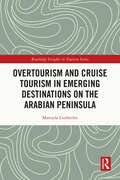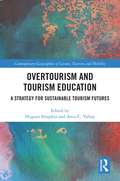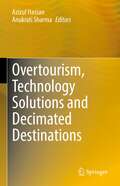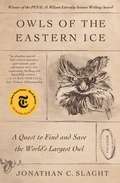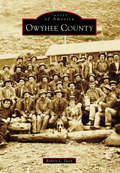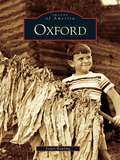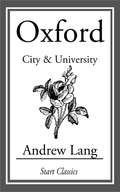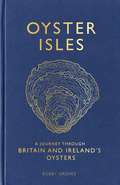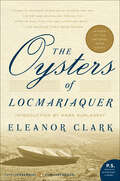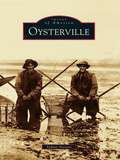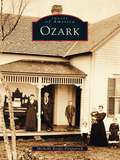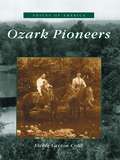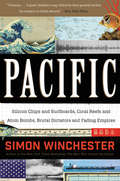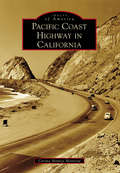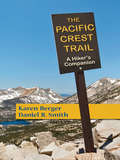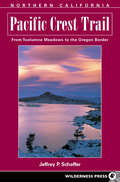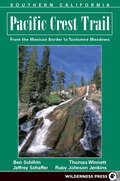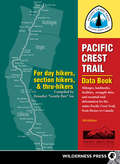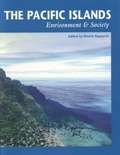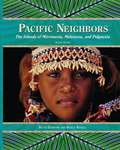- Table View
- List View
Overtourism and Cruise Tourism in Emerging Destinations on the Arabian Peninsula (Routledge Insights in Tourism Series)
by Manuela GutberletCruise tourism is one of the fastest growing sectors worldwide. This book is the first of its kind to provide in-depth insights into the emergence of mega-cruise tourism in destinations on the Arabian Peninsula and its impacts on local communities, their spaces, cultures, identities and tourist experiences. It offers a micro-sociological analysis, calling for holistic, participatory, mindful approaches and to rethink current exploitative tourism planning and development. It assumes a high political, social and economic importance within globalization. It draws on a long-term field study in an under-researched region in Asia that developed large-scale tourism recently to diversify the economy. The book provides insights on the destination development from a state of continuous growth to a sudden fall in tourism activities due to a sudden shock, caused by the global health pandemic and its resilience. It explores the sociocultural, economic and spatial challenges faced in international tourism development and its power relations analysed from different perspectives and within time. It analyses time-space compression, overtourism, urban tourism, nature-based tourism, enclavization, social capital, imaginaries, Cultural Ecosystem Services, slow tourism as well as just tourism. The book provides an innovative contribution to the planning and development of tourism destinations, communities and their spaces in which tourism operates in a fast pace. It will be of interest to academics, undergraduate and postgraduate students in the field of tourism and hospitality management, geography, sociology, anthropology, urban planning and environmental sciences. Moreover, the book will be useful for practitioners and policymakers around the globe, as well as all those interested in the fast emergence and the impacts of mega-cruise tourism.
Overtourism and Tourism Education: A Strategy for Sustainable Tourism Futures (Contemporary Geographies of Leisure, Tourism and Mobility)
by Hugues Séraphin Anca C. YallopSince 2017, the term ‘overtourism’ has become the buzzword for destinations suffering the strain of tourism. It is a critical issue for the 21st century and beyond, and to date has only been examined from a tourism industry perspective. This book takes a different stand by investigating overtourism from a tourism education perspective. The recent global COVID-19 pandemic was expected to halt travel and, arguably, overtourism. However, industry experts and researchers share the opinion that instead of declining, overtourism is simply experiencing a shift, with a swarm of ‘second home’ and domestic travel that is likely to engulf many tourism destinations. Against this backdrop, the issue of overtourism remains relevant and studies on ways to cultivate responsible consumer mindsets to deal with overtourism and other sustainability issues in the tourism industry are called for. This book focuses on education as a transformative and strategic tool to tackle overtourism and related negative impacts. It presents original research on the topics of overtourism, education, and sustainability, and puts forward a range of practical and transformative tourism education strategies to mitigate overtourism and to promote the sustainable development of destinations. This book will be of great interest to upper-level students, researchers, and academics in tourism, development studies, cultural studies, and sustainability, as well as professionals in the field of tourism management.
Overtourism, Technology Solutions and Decimated Destinations
by Azizul Hassan Anukrati SharmaThis book meticulously focuses on seeing technological solutions of overtourism on decimated destinations from a comprehensive viewpoint. Considering the present crisis situation, the global tourism industry is in need to formulate revised strategies to recover and to be more resilient. The book creates a platform to deliberate the measures needed to be taken to tackle the issue of this most recent crisis of COVID-19 on the lens of overtourism and technology application. The book adds some unique suggestions to direct a new outlook towards overtourism, technology solutions and decimated destinations. This book discusses the responsibilities of tourists towards decimated destinations as well as provides in-deep knowledge and debates about technological solutions to overtourism in decimated destinations.
Owls of the Eastern Ice: A Quest to Find and Save the World's Largest Owl
by Jonathan C. SlaghtA New York Times Notable Book of 2020Longlisted for the National Book AwardWinner of the PEN/E.O. Wilson Literary Science Writing Award and the Minnesota Book Award for General NonfictionA Finalist for the Stanford Dolman Travel Book of the Year AwardWinner of the Peace Corps Worldwide Special Book AwardA Best Book of the Year: NPR, The Wall Street Journal, Smithsonian, Minneapolis Star-Tribune, The Globe and Mail, The BirdBooker Report, Geographical, Open Letter ReviewBest Nature Book of the Year: The Times (London)"A terrifically exciting account of [Slaght's] time in the Russian Far East studying Blakiston’s fish owls, huge, shaggy-feathered, yellow-eyed, and elusive birds that hunt fish by wading in icy water . . . Even on the hottest summer days this book will transport you.” —Helen Macdonald, author of H is for Hawk, in KirkusI saw my first Blakiston’s fish owl in the Russian province of Primorye, a coastal talon of land hooking south into the belly of Northeast Asia . . . No scientist had seen a Blakiston’s fish owl so far south in a hundred years . . . When he was just a fledgling birdwatcher, Jonathan C. Slaght had a chance encounter with one of the most mysterious birds on Earth. Bigger than any owl he knew, it looked like a small bear with decorative feathers. He snapped a quick photo and shared it with experts. Soon he was on a five-year journey, searching for this enormous, enigmatic creature in the lush, remote forests of eastern Russia. That first sighting set his calling as a scientist.Despite a wingspan of six feet and a height of over two feet, the Blakiston’s fish owl is highly elusive. They are easiest to find in winter, when their tracks mark the snowy banks of the rivers where they feed. They are also endangered. And so, as Slaght and his devoted team set out to locate the owls, they aim to craft a conservation plan that helps ensure the species’ survival. This quest sends them on all-night monitoring missions in freezing tents, mad dashes across thawing rivers, and free-climbs up rotting trees to check nests for precious eggs. They use cutting-edge tracking technology and improvise ingenious traps. And all along, they must keep watch against a run-in with a bear or an Amur tiger. At the heart of Slaght’s story are the fish owls themselves: cunning hunters, devoted parents, singers of eerie duets, and survivors in a harsh and shrinking habitat.Through this rare glimpse into the everyday life of a field scientist and conservationist, Owls of the Eastern Ice testifies to the determination and creativity essential to scientific advancement and serves as a powerful reminder of the beauty, strength, and vulnerability of the natural world.
Owyhee County
by Robert L. DeenThe sprawling high desert wilderness of southwestern Idaho was virtually unknown to whites in 1863, when Mike Jordan and a band of placer miners dipped their pans into the creek that bears his name and found gold. The electrifying news spread, and the people came. Towns sprang up overnight on the mountaintops. Some disappeared almost as quickly as they had appeared. "Men needed to work the mines!" cried Idaho's newspapers. The word went out, and the miners came from Nevada, California, Colorado, and across the West. Soon the great mines of War Eagle Mountain rivaled Nevada's fabled Comstock Lode. With the exception of Silver City, one of America's largest intact ghost towns, the boomtowns, as well as the mines, are gone; however, descendants of the miners remain. Owyhee County is the size of Delaware and Connecticut combined--7,679 square miles--with a population of only 11,500. It is a rarely visited land of few roads and fewer people, sagebrush desert, deep basalt canyons, romantic vistas, and mysterious mountains that still hide their gold and silver.
Oxford: 200 Years Of Oxford History (Images of America)
by Lewis BowlingOxford, North Carolina, is the historic seat of Granville County. The rolling hills of the Piedmont have long been one of the country's leading tobacco-producing regions. For a number of years during the 1800s, Granville grew more tobacco than any other county in the state. High production levels continued through the 1900s. In its time, the Oxford Tobacco Research Station was the largest facility of its kind in the world. With the tobacco industry contributing so much to the local economy, Oxford has much to show for its success. The town is widely known for its beautiful historic homes. With educational institutions such as Oxford Female College and the Horner Military School, Oxford was once called the Athens of the South. Many influential people have called Oxford home. The historic images presented in this book explore these fascinating aspects of Oxford's history.
Oxford
by Valerie Edwards ElliottIn the early 1800s, a wooded hilltop in southwestern Ohio became the site for Miami University and the town of Oxford. Miami was named for the area's Native American inhabitants and Oxford for the university town in England. By mid-century, Oxford was a well-established academic community featuring a university plus a men's theological seminary and three educational institutions for women. Oxford depicts the town's historic ties to higher education and its notable people, including U.S. President Benjamin Harrison and his wife Caroline Scott, author William Holmes McGuffey, and apiarist Lorenzo Langstroth. Today's Oxford continues to offer superior educational opportunities, athletic events, and cultural activities.
Oxford: City and University
by Andrew LangAndrew Lang (1844-1912) was a prolific Scots man of letters, a poet, novelist, literary critic and contributor to anthropology. He now is best known as the collector of folk and fairy tales. He was educated at the Edinburgh Academy, St Andrews University and at Balliol College, Oxford. As a journalist, poet, critic and historian, he soon made a reputation as one of the ablest and most versatile writers of the day. Lang was one of the founders of the study of "Psychical Research," and his other writings on anthropology include The Book of Dreams and Ghosts (1897), Magic and Religion (1901) and The Secret of the Totem (1905). He was a Homeric scholar of conservative views. Other works include Homer and the Epic (1893); a prose translation of The Homeric Hymns (1899), with literary and mythological essays in which he draws parallels between Greek myths and other mythologies; and Homer and his Age (1906). He also wrote Ballades in Blue China (1880) and Rhymes la Mode (1884).
Oxford
by Jan Morris Mark MorrisKing James I once said that if he were not a king he would like to be an Oxford man. This classic volume -- now in its third edition -- recounts the character, history, mores, buildings, climate, and people of an uncategorizable city. Exploring this ancient British crossroads beside the Thames, Jan Morris -- a distinguished travel writer and novelist--focuses on the richly-mixed heritage of city and University, replete with ongoing battles between "Town and Gown." She investigates the spirit and pride of each individual Oxford college; offers detailed descriptions of the flora and fauna, especially in the Oxford Botanical Garden, the oldest of its kind in Great Britain; depicts the pleasures and recreations, as well as the education and scholarship, of the students; and traces the city and the University's Christian roots. Her witty prose reveals the Oxford which gave the world the MG sports car and educated twenty-two British Prime Ministers. This newly revised edition brings up to date a portrait of a small city which has given its name to a marmalade, bags, a gray, shoes, a Group, a Movement, a dictionary, and an accent.
Oyster Isles: A Journey Through Britain and Ireland's Oysters
by Bobby Groves'Bobby's oyster travelogue is an ambitious, one-of-a-kind piece that shines a spotlight on the extraordinary and the everyday of the industry. It's the stuff that oyster bucket lists are made of' Julie Qiu, In A Half Shell blog'A masterpiece' Sandy Ingber, Executive Chef of the Grand Central Oyster Bar, New York'An amazing tome . . . The stories behind each oyster and location are informative, in depth, but, most importantly, fun' Michel Roux JrThe oyster. Ostrea edulis. 'Edible bones'. The Great British oyster is deeply embedded in our geographical, historical and socio-cultural landscape. Five-thousand-year-old oyster shells have been discovered in the northern reaches of Scotland, and oyster shells are littered along the extinct riverbeds deep beneath the London of today. A highly prized delicacy of the Romans, the oyster has always been a class leveller: an everyman food of the poor during the Victorian age to a food of decadence during the twentieth century. It is a superfood; a biological water meter; an ecological superpower. The oyster card, 'the world is your oyster' - it has even crept into our language.Bobby Groves, Head of Oysters at the Chiltern Firehouse, takes us on a wonderful journey of the British oyster, a five-thousand-mile motorcycle odyssey of Britain's spectacular coastlines. He vividly brings to life this strange and marvellous creature, shining a light on its rich and vibrant history, its cultural impact and ecological importance as well as those oyster folk who work so hard to protect them.Part travelogue, part social history, Oyster Isles is a celebration of the much-loved yet much-misunderstood British oyster.
The Oysters of Locmariaquer
by Eleanor ClarkWinner of the National Book Award“What an elegant book this is, starting with that most elegant of creatures, the Belon oyster. . . . [Clark’s] fantastic blending of science and art, history and journalism, brings the appetite back for life and literature both.” — Los Angeles Times Book ReviewOn the northwest coast of France, just around the corner from the English Channel, is the little town of Locmariaquer (pronounced "loc-maria-care"). The inhabitants of this town have a special relationship to the world, for it is their efforts that maintain the supply of the famous Belon oysters, called les plates ("the flat ones"). A vivid account of the cultivation of Belon oysters and an excursion into the myths, legends, and rich, vibrant history of Brittany and its extraordinary people, The Oysters of Locmariaquer is also an unforgettable journey to the heart of a fascinating culture and the enthralling, accumulating drama of a unique devotion.
Oysterville
by Sydney StevensFor generations, Chinook Indians camped in the area that is now Oysterville, gathering oysters from the shallow waters of Shoalwater Bay. When tribal elder "Old Klickeas" introduced two young adventurers, Robert Hamilton Espy and Isaac Alonzo Clark, to the oyster treasure, the pioneer boom years began. Oysters were marketed in gold-rich, oyster-hungry San Francisco, where a plateful sold for $50. Within months, there were several hundred settlers, and in 1855, Oysterville was chosen as the seat of Pacific County, Washington Territory. Oysterville had many county firsts: a school, a college, a newspaper, a post office, and a church--but never a bank. When schooners arrived to pick up their oyster cargoes, oystermen were paid in gold coin that then might be buried or stashed under floorboards for safekeeping. Often there was more gold in Oysterville than in any town on the West Coast except San Francisco. Today the peaceful vistas along the lanes and shoreline of the village belie its tumultuous history. Oysterville was listed on the National Register of Historic Places in 1976.
Ozark
by Michelle Korgis-FitzpatrickThe name Ozark comes from the French Aux Arcs. The town of Ozark may have gotten its name because it is at the bend of the creek. Today the term Ozark refers to the large upland region that covers parts of Missouri, Arkansas, Oklahoma, and Kansas. Ozark, Missouri is nestled in the hills of this region and serves as the county seat of Christian County. This book looks at Ozark's 150 year history, using vintage photographs from the Pegram Collection to capture the spirit of the town and surrounding areas. Ozark has long prided itself on its hospitality, and that is evident here in the images of people, events, schools, railroads, and more that have made Ozark the warm and friendly town it is today.
Ozark Pioneers
by Vickie Layton CobbIn the early 1800s, rugged and self-sufficient pioneers left their native homelands to tame the wild Ozark territory. These early settlers left their mark on history, as they settled Taney County, and became Missouri's first families.With family stories and photographs passed down from generation to generation, Ozark Pioneers shares the experiences of the first residents of the area. Family names such as Allen, Coggburn, Smith, Whorton, Layton, Bollinger, Brittain, and Rittenhouse appear throughout the history of Taney County, demonstrating the roots and growth of the wild Ozark territory. From the bloody days of battle in the Civil War, to the continuous fight against the outlaws in the Bald Knobber era, these pages detail the courage, hardships, and strength of theses founding families in an untamed land.
Pacific
by Simon WinchesterFrom New York Times bestselling author Simon Winchester, author of Atlantic and The Men Who United the States, a colorful and provocative exploration of the modern Pacific Ocean--what it has been and the grip it holds on our futureSimon Winchester tackles this "oceanic behemoth of eye-watering complexity" by focusing on key moments since 1950 that speak to the greater trends and larger truths about the ocean's significance to us today.Winchester leads us from the Bering Strait to Cape Horn, the Yangtze River to the Panama Canal, and to the many small islands that lie in between. He recounts the atomic tests on the atoll of Bikini, which created a surreal landscape that must still be left vacant for fear of radiation poisoning. He takes us to the launch of "Gidget"--her movies, her TV show, and, most important, her surfboards, which would forever change how the world's youth views a rising wave. Pacific also tells the story of the little transistor radio and how it sparked the digital revolution, from Japan to Silicon Valley, altering the ocean's destiny. Winchester includes tales of alarming discoveries on the Great Barrier Reef and grand expeditions to mysterious vents on the ocean's floor. He examines the geopolitical shifts that shaped the ocean's vast land areas, from the rise of North Korea's rogue state to the end of European colonization, and addresses the environmental degradation and climate shifts that now threaten this majestic body of water.Along the way, Winchester looks at the political turmoil in Australia, the relationship between the Koreas, and recent confrontations that engaged China and the United States. "The Pacific," he writes, "is the ocean where, quite literally, East meets West. . . . [T]here is challenge in the air, the sound of clashing swords and angry words."Calling upon Winchester's many journeys throughout the Pacific and its surrounding areas, his formidable historical understanding, and his singular talent for storytelling, Pacific is a paean to this magnificent sea of beauty and myth that has long captured the imagination.
Pacific Coast Highway in California (Images of America)
by Carina Monica MontoyaMore commonly known as Pacific Coast Highway, State Route 1 ribbons along or near the Pacific Ocean from Northern California at Leggett in Mendocino down to Southern California at San Juan Capistrano in Orange County. Its construction began in 1913 and was done incrementally, largely because of funding issues, shortage of labor, legal challenges, deep canyons, steep mountains, solid rock, and unstable earth. A true modern marvel, its unique and extraordinary construction allows easy access to some of the country's most famous and historical places and picturesque sights. Thousands of pounds of dynamite were used to blast through granite, marble, and sandstone to build a highway following near or along the coastline. Among the 33 bridges along the route is the remarkable Bixby (Rainbow) Bridge at Big Sur. The highway wends its way through some of the most magnificent and scenic landscapes and historical places found between Ventura and Humboldt Counties, making it more than just a road. It is a destination.
Pacific Coasting: A Guide to the Ultimate Road Trip, from Southern California to the Pacific Northwest
by Danielle Kroll&“Your illustrated guide to the perfect West Coast road trip.&”—C magazine Roll down the windows, turn up the radio, and take a drive up the world&’s most magical coastline. It&’s a beautiful and practical travel guide. An illustrated keepsake. An inspiration to get out and visit. And a celebration of the wild, lush, larger-than-life 2,000 miles that run along the edge of the West Coast through California, Oregon, Washington, and Vancouver Island, where you&’ll find everything from stunning vistas and alluring beaches to botanical gardens, nature trails, antiques stores, charming villages, and a handful of great cities along the way. Created by artist and inveterate road-tripper Danielle Kroll, Pacific Coasting covers all the not-to-be-missed stops, while including maps, packing lists and playlists (yes, what to listen to as you&’re driving up to Hearst Castle), and specific guides like Tide Pool Etiquette and Oregon Lighthouses. The result is the offbeat adventure of a lifetime, filled with something new to discover every hour of every day.
The Pacific Crest Trail: A Hiker's Companion (Second Edition)
by Karen Berger Daniel R. SmithThis book begins where basic trail guides and maps leave off. For each section of the trail, the authors describe the route in detail and recommend the best day hikes and short backpacks from each trailhead. They describe the plants and animals hikers will see, tell stories about local history, explain plate tectonics, and in a thousand other ways enrich your experience of the journey. For many people, the Pacific Crest Trail is the ultimate long-distance hiking trail. Beginning in the dry valleys of southern California, it follows the crest of the snow-capped Sierras and ends in the ancient forests of Washington's Cascades. Along the way, national treasures such as Yosemite, Crater Lake, and Mount Rainier make this trail one of the premier hiking destinations in the world. But hiking is about much more than getting from A to B. Berger and Smith draw on their tremendous experience--together they have logged more than 12,000 miles on the PCT--to give tested advice to long-distance hikers on trip planning, gear and safety, seasonal considerations, trailheads and resupplies, permits, and much more.
The Pacific Crest Trail: A Visual Compendium
by Joshua M. PowellThe Pacific Crest Trail as you've never seen it before! A visual feast for the senses, this highly designed paperback showcases the PCT through clever infographics, modern illustration, and insightful text. The book captures both the grandeur of the West Coast as well as the tiniest things that a thru-hiker notices and experiences during a 140-day trek.Through the written word, graphic design, and illustration, The Pacific Crest Trail: A Visual Compendium conveys the beauty and the beastliness of a 2,650-mile wilderness hike from Mexico to Canada. The author chronicles the PCT through infographics about the trail and the thru-hikers' experience, and includes arresting illustrations of the landscape and minutiae of the trail. Everything from trail markers, weather challenges, and the stories behind popular toponyms to the songs stuck in a hiker's head, thru-hiker trail names, and food consumed will be addressed, making this an ideal gift for any outdoor enthusiast.
Pacific Crest Trail: Northern California
by Jeffrey P. SchafferFrom the time the PCT leaves the Mexican border, until it reaches Canada, it has traveled 2,650 miles through 24 national forests, 37 wilderness areas, and 7 national parks. In Pacific Crest Trail: Northern California, you'll meet up with the PCT in Yosemite National Park's Tuolumne Meadows, then hike, climb, descend, and switchback your way to the Oregon border. You'll discover rivers, peaks, forests, meadows, fascinating geological formations, and other natural wonders. You'll pass through Emigrant, Desolation, and Marble Mountain wildernesses; Trinity Alps and Lassen National Park; and, you'll see Lake Tahoe, Burney Falls, Mt. Shasta, and Castle Crags. This book helps you locate the PCT and side-trips, find water sources, and access resupply routes. Jeffrey P. Schaffer also describes the rich geological and natural history of these mountains. Information on camping, permits, and the best seasons to go is provided along with updated maps.
Pacific Crest Trail: Oregon and Washington
by Andy Selters Jeffrey P. SchafferThe 2650-mile Pacific Crest Trail, adopted by Congress as a National Scenic Trail, passes through some of the most breathtaking scenery in the United States. Hiking along this ridge-crest route, you'll see Mt. Jacinto, Mt. Whitney, Lassen Peak, Mt. Shasta, Mt. Hood, Mt. Adams, Mt. Rainier and Glacier Peak. You'll traverse 24 national forests, 34 wilderness areas, 7 national parks, plus numerous other parks and recreational areas. Trail elevations range from near sea level at the Columbia River on the Oregon-Washington border, to 13,180 feet at Forester Pass in the High Sierra. Written by accomplished hikers who have each logged over 5,000 trail miles, this book is the only accurate, comprehensive guide to the Pacific Crest Trail in Oregon and Washington. Featuring a complete map of the route, in the form of 149 topographic strip maps, Pacific Crest Trail: Oregon & Washington will give you an extensive description of the trail, tips on planning your hike, history of the trail, and information on the region's natural history, geology and ecology.
Pacific Crest Trail: Southern California
by Thomas Winnett Ben Schirfin Jeffrey P. Schaffer Ruby Johnson JenkinsFirst published in 1973, The Pacific Crest Trail, Vol. 1, California quickly established itself as the "PCT Bible"- the book trekkers could not do without. Now thoroughly updated and redesigned into two portable volumes, Pacific Crest Trail: Southern California starts at the Mexican border and guides you to Yosemite's beautiful back country. Its companion volume meets the trail at Tuolumne Meadows and drops you at Oregon's door. Thru-hikers to Canada will find the rest of their journey in Pacific Crest Trail: Oregon & Washington. Our PCT gurus help you locate the trail, water sources, and resupply access routes with detailed descriptions, customized maps, and tips on alternate routes. Whether you're planning day hikes, weekend or week long backbacks, or an ambitious thru-hike, everything you need to know about-from bears to trees-is here.
Pacific Crest Trail Data Book
by Benedict GoThe essential, cut-to-the-chase handbook to the Pacific Crest Trail, based on the comprehensive Wilderness Press guidebooks to the PCT, has been completely updated. Packed with trail-tested features, it's useful both on and off the trail, covering pre-trip planning for resupply stops, how to set daily on-the-trail mileage goals by knowing trail gradient and the locations of campsites, water sources, and facilities, and how to easily calculate distances between any two points on the trail, and how to planning both north-bound and south-bound hiking trips.
The Pacific Islands: Environment and Society
by Moshe RapaportAcademic survey of the Pacific Islands.
Pacific Neighbors: The Islands of Micronesia, Melanesia, and Polynesia (Second Edition)
by Betty Dunford Reilly RidgellThe book is all about the Pacific islands and talks about the geography, history, and culture of the islands and island groups of Micronesia, Melanesia, and Polynesia.
